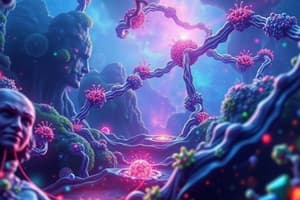Podcast
Questions and Answers
What is a characteristic of first generation sequencing compared to the other generations?
What is a characteristic of first generation sequencing compared to the other generations?
- It uses ligation and synthesis methods.
- It generates longer sequence reads.
- It is more expensive and time-consuming. (correct)
- It does not involve electrophoresis.
Which generation of sequencing can generate long reads of sequences at a time?
Which generation of sequencing can generate long reads of sequences at a time?
- Fourth generation sequencing
- First generation sequencing
- Third generation sequencing (correct)
- Second generation sequencing
What is one primary benefit of third generation sequencing compared to second generation sequencing?
What is one primary benefit of third generation sequencing compared to second generation sequencing?
- It is less costly and less time-consuming. (correct)
- It is dependent on electrophoresis.
- It requires more extensive annotation.
- It involves more manual labor.
Which of the following is NOT a category of biological databases?
Which of the following is NOT a category of biological databases?
Which database is recognized for storing sequences of proteins and nucleic acids?
Which database is recognized for storing sequences of proteins and nucleic acids?
What type of additional information is typically stored along with sequences in NCBI databases?
What type of additional information is typically stored along with sequences in NCBI databases?
Which of the following statements about structural databases is true?
Which of the following statements about structural databases is true?
Which of these databases is NOT primarily a sequence database?
Which of these databases is NOT primarily a sequence database?
What is the primary purpose of the Ensembl database?
What is the primary purpose of the Ensembl database?
Which database is specifically focused on single nucleotide polymorphisms?
Which database is specifically focused on single nucleotide polymorphisms?
Which database does NOT provide genome assemblies but rather annotations?
Which database does NOT provide genome assemblies but rather annotations?
What type of information does the 1000 Genomes database primarily catalog?
What type of information does the 1000 Genomes database primarily catalog?
Which database integrates information specifically about essential genes?
Which database integrates information specifically about essential genes?
Who developed the GenPept database?
Who developed the GenPept database?
Which of the following databases contains data purely related to mitochondrial genomes?
Which of the following databases contains data purely related to mitochondrial genomes?
Which option describes a database characterized primarily for allele frequencies?
Which option describes a database characterized primarily for allele frequencies?
What is the primary function of the EMBL Nucleotide Sequence Database?
What is the primary function of the EMBL Nucleotide Sequence Database?
Which of the following is NOT a component of the RefSeq database?
Which of the following is NOT a component of the RefSeq database?
What role does the DNA Data Bank of Japan (DDBJ) primarily fulfill?
What role does the DNA Data Bank of Japan (DDBJ) primarily fulfill?
Which database is primarily used in genomic and proteomic research for annotated sequences?
Which database is primarily used in genomic and proteomic research for annotated sequences?
Which bioinformatics tools are provided by the European Bioinformatics Institute (EBI)?
Which bioinformatics tools are provided by the European Bioinformatics Institute (EBI)?
Which of the following statements accurately describes GenBank?
Which of the following statements accurately describes GenBank?
Which organization is primarily responsible for the maintenance of the EMBL Database?
Which organization is primarily responsible for the maintenance of the EMBL Database?
Flashcards
Third-generation sequencing
Third-generation sequencing
Sequencing technique that's less expensive and faster than first-generation methods. It bypasses electrophoresis and uses ligation/synthesis.
Biological databases
Biological databases
Organized collections of DNA, RNA, and protein information, freely available for research.
Sequence databases
Sequence databases
Categories of biological databases storing DNA, RNA, and protein sequences.
Structure databases
Structure databases
Signup and view all the flashcards
Functional databases
Functional databases
Signup and view all the flashcards
NCBI databases
NCBI databases
Signup and view all the flashcards
EMBL Database
EMBL Database
Signup and view all the flashcards
DDBJ Database
DDBJ Database
Signup and view all the flashcards
Ensembl database function
Ensembl database function
Signup and view all the flashcards
Ensembl's role
Ensembl's role
Signup and view all the flashcards
GenBank and DDBJ
GenBank and DDBJ
Signup and view all the flashcards
Protein sequence databases
Protein sequence databases
Signup and view all the flashcards
GenPept database
GenPept database
Signup and view all the flashcards
dbSNP
dbSNP
Signup and view all the flashcards
RefSeq
RefSeq
Signup and view all the flashcards
Allele Frequency Net Database (AFND)
Allele Frequency Net Database (AFND)
Signup and view all the flashcards
EMBL/DDBJ/GenBank
EMBL/DDBJ/GenBank
Signup and view all the flashcards
EMBL Nucleotide Sequence Database
EMBL Nucleotide Sequence Database
Signup and view all the flashcards
DDBJ
DDBJ
Signup and view all the flashcards
Reference Sequence
Reference Sequence
Signup and view all the flashcards
Ensembl
Ensembl
Signup and view all the flashcards
Comparative genomics
Comparative genomics
Signup and view all the flashcards
Nucleotide Sequence Databases
Nucleotide Sequence Databases
Signup and view all the flashcards
Study Notes
Bioinformatics and Genomic Databases
- Bioinformatics utilizes information technology to collect, store, retrieve, and analyze biological data like sequences and structures of proteins and nucleic acids.
- Biological databases are organized into Sequence, Structure, and Functional categories.
- The first database was created after insulin protein sequencing in 1956. Insulin contains 51 amino acid residues.
History of Biological Databases
- 1965: Margaret Dayhoff created the Atlas of Protein Sequence and Structure.
- 1980s: EMBL Data Library cataloged biological data.
- 1982: GenBank was established.
- 2002: The development of high-throughput sequencing systems sequenced the complete E. coli genome.
- Present: Creation of directories for multi-omic data.
Types of Biological Databases
- Bibliographic Databases: Contain research articles and papers from various journals, like PubMed.
- Sequence Databases: Store protein and nucleotide sequences. Examples are GenBank, DDBJ, and PIR.
- Structure Databases: Contain 3D structures of proteins and nucleic acids (PDB).
- Taxonomic Databases: Provide information about Earth's species of animals, plants, and more. Example includes Catalogue of life
- Metabolic Databases: Contain data on biological pathways (KEGG and MetaCyc).
- Model Organism Databases: Contain extensive biological data on studied model organisms (Flybase, RGD).
- Chemical Databases: Contain data on small organic molecules (PubChem).
- Microarray Databases: Store gene expression data from microarray experiments. Example includes GEO
- Enzyme Databases: Contain information on enzyme structure and function (BRENDA).
- Disease Databases: Collect disease-related information. Example includes OMIM
Sequence Data Generation
- Sequencing plays a crucial role in biological data analysis.
- Researchers now use in silico analysis as a first-line method in biomedical research, replacing the more costly and time-consuming in vitro and in vivo methods.
- Sanger sequencing was the first generation of sequencing and it uses dideoxy nucleotides to halt the chain extension.
- Maxam-Gilbert sequencing is another first-generation method based on chemical degradation.
- Second-generation sequencing (e.g., Illumina) generates millions of short reads in parallel, is less expensive, and less time-consuming. It uses synthesis methods instead of electrophoresis
- Third-generation sequencing (e.g., SMRT, Nanopore) uses single-molecule sequencing and produces longer reads but may have lower accuracy.
Nucleotide Sequence Databases
- EMBL/DDBJ/GenBank: A primary nucleotide sequence resource, crucial for storing human genome sequence data
- EMBL-Bank: Maintained by the European Bioinformatics Institute (EBI).
- DDBJ: DNA Data Bank of Japan.
- RefSeq: A comprehensive and annotated collection of publicly available nucleotide and protein sequences.
- Data is generated using various techniques depending on the sequence class and organism.
- Databases use accession numbers to help in identifying and tracking particular sequences in the databases.
Protein Sequence Databases
- UniProt: A comprehensive and freely accessible protein sequence and functional information database.
- AlphaFold: A Google DeepMind AI that predicts protein 3D structures from the amino acid sequence.
Additional Information
- NCBI databases are located at www.ncbi.nlm.nih.gov, EMBL database is located at https://www.ebi.ac.uk/, and DDBJ is located at https://www.ddbj.nig.ac.jp/.
- Ensembl is a genome browser tool for vertebrate genomes, supporting research, sequence variation, and transcriptional regulation on various publicly available vertebrate genome assemblies.
Studying That Suits You
Use AI to generate personalized quizzes and flashcards to suit your learning preferences.




